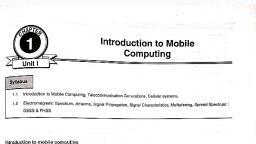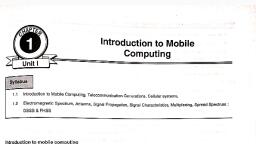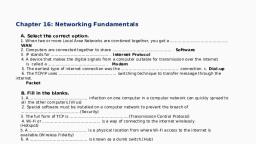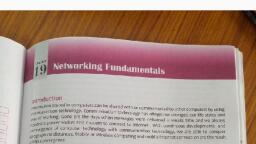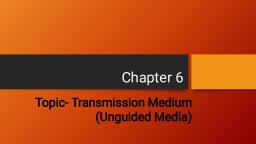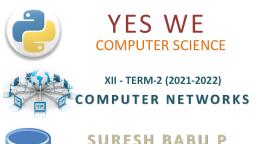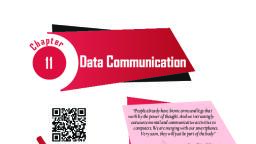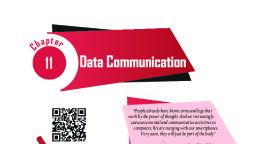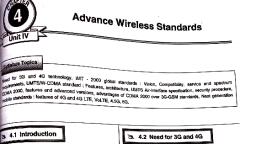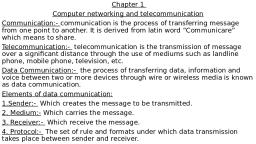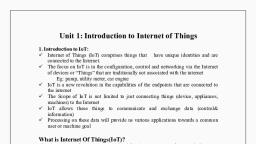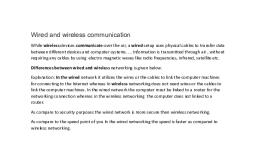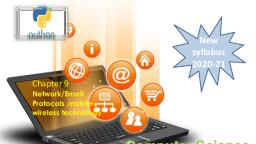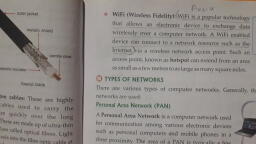Page 1 :
CHAPTER – 4 FRAMEWORK OF MCOMMERCE, i- Mode- is the packet-based service for mobile phones offered by Japan's leader in wireless technology, NTT DoCoMo., Unlike most of the key players in the wireless arena, i-Mode uses the Wireless Application Protocol (WAP) and uses a, simplified version of HTML, Compact Wireless Markup Language (CWML) instead of WAP's Wireless Markup Language, (WML)., NTT DoCoMo i-mode, Is a mobile internet (as opposed to wireless internet) service popular in Japan. Unlike Wireless Application Protocol, imode encompasses a wider variety of internet standards, including web access, e-mail, and the packet-switched, network that delivers the data. i-mode users have access to various services such as e-mail, sports results, weather, forecast, games, financial services, and ticket booking. Content is provided by specialized services, typically from the, mobile carrier, which allows them to have tighter control over billing, There are essentially four main components that are required for the i-Mode ser i e. They are as follo s −, • A cellular phone capable of voice and packet communication and with a browser installed., • A packet network., • An i-mode server., • Information providers, i-Mode Net orks utilize t o types of o puters − servers and clients. Servers are the computers that hold, information and they are called DoCoMo i-Mode Centers. Clients are the computers that we view the information and, they are cellular i-Mode phone. There are two other important components involved in connecting to a wireless, network. In order to connect a cellular network to a server, a gateway must exist. Also, the web site must be in an iMode format., Services offered by i-mode:, I-Appli: This service offers Java based software applications that can be downloaded in i-mode compatible, smartphones and allows the users to automatically update news/ traffic/ weather forecasts as well as download latest, games., I-Area: This is a location based service that provide local news/ traffic/ weather forecasts and other location specific, infor atio ased o user’s geographi al positio . It also offers ap- ased a igatio al ser i es ased o user’s, current location., I-Shot: This service supports transfer of still images from one i–mode enabled phone to other phones under different, carriers., I-Channel: This is a content distribution service that displays latest news, weather forecasts and other information on, the mobile screen of the user., Wireless communication, sometimes simply wireless, is the transfer of information or power between two or more points that are not, connected by an electrical conductor. The most common wireless technologies use radio waves. With radio waves, distances can be short, such as a few meters for Bluetooth or as far as millions of kilometers for deep-space radio, communications. It encompasses various types of fixed, mobile, and portable applications, including two-way radios,, cellular telephones, personal digital assistants (PDAs), and wireless networking., Other examples of applications of radio wireless technology includes wireless computer mice, keyboards and, headsets, headphones, radio receivers, satellite television, broadcast television and cordless telephones.
Page 2 :
WIRELESS DEVICES FOR M.COMMERCE, Wireless e-commerce (also called mobile commerce or m-commerce) is the promotion, buying, and selling of goods, and services through electronic data communication networks that interface with wireless (or mobile) devices., Wireless e-commerce is a subset of wireless computing, which is the accessing of information systems by wireless, means. Many of the issues that affect wireless computing in general also affect wireless e-commerce, An increasing number of technologies and applications have begun to focus on mobile computing and the wireless, We . Mo ile o, er e − o, er e e o passes all a ti ities related to a pote tial o, er ial tra sa tio, conducted through communications networks that interface with wireless (or mobile) devices., Ultimately, researchers and developers must determine what tasks users really want to perform anytime from, anywhere and decide how to ensure that information and functionality to support those tasks are readily available and, easily accessible, The devices currently most important to m-commerce can be classified according to the categories., Laptop Computer, Handheld, Telephone, Hybrid, Wearable, Vehicle mounted, Specialty, Input Interaction with Wireless Devices - Input interaction concerns the ways in which users enter data or commands., Common technologies used for input interaction with wireless devices include keyboards, keypads, buttons, cameras,, microphones, and scanners., Location based services (LBS), are ser i es offered through a o ile pho e a d take i to a ou t the de i e’s geographi al lo atio . LBS typi ally, pro ide i for atio or e tertai e t. Be ause LBS are largely depe de t o the o ile user’s lo atio , the pri ary, o je ti e of the ser i e pro ider’s syste is to deter i e here the user is., Location-based services (LBS) use real-time geo-data from a mobile device or smartphone to provide information,, entertainment or security. Some services allow consumers to "check in" at restaurants, coffee shops, stores, concerts,, and other places or events. Often, businesses offer a reward — prizes, coupons or discounts — to people who check, in. Google Maps, Foursquare, GetGlue, Yelp and Facebook Places are among the more popular services., A location-based service (LBS) is a software-level service that uses location data to control features. As such LBS is, an information service and has a number of uses in social networking today as information, in entertainment or, security, which is accessible with mobile devices through the mobile network and which uses information on the, geographical position of the mobile device., An LBS requires five basic components:, •, the service provider's software application, • a mobile network to transmit data and requests for service,, • a content provider to supply the end user with geo-specific information,, • a positioning component (see GPS) and, • the end user's mobile device.
Page 3 :
Uses of location-based service, Store locators- Using location-based intelligence, retail customers can quickly find the nearest store location., Proximity-based marketing- Location-based mobile marketing delivers ads to potential customers within that city who, might actually act on the information., Travel information. An LBS can deliver real-time information, such as traffic updates or weather reports, to the, smartphone so the user can plan accordingly., Roadside assistance. In the event of a blown tire many roadside assistance companies provide an app that allows, them to track your exact location without the need for giving directions., Mobile workforce management. For logistics-dependent companies that employ individuals out in the field or at, multiple locations, an LBS allows employees to check in at a location using their mobile device., , TYPES OF NETWORKS, Computer network can be classified according to their geographical area and their uses., Depending upon the geographical area covered by a network, it is classified as:, Local area network(LAN), Wide area network(WAN), Personal area network(PAN), Metropolitan area network(MAN), Campus Area Network (CAN), Home Area Network(HAN), Wireless Local Area Network (WLAN), Local Area Network (LAN), A LAN is a small and privately owned network to provide local connectivity within a small region. "A regio ” refers to, the same office, the same building, the same company and in the same schools. It provide different services like, document management, sharing resources, workgroup scheduling, e-mail and fax communications services, It has a limited rea h, roughly a u h of losely situated houses or uildi g. A d that’s e ause e typically use the, Ethernet technology (IEEE 802.3) to power our local area networks. The Ethernet cables we lay across our houses and, offices have their practical limitations. Beyond a certain length, the speed gets degraded., Advantages, Lower in cost, Sharing of Resources, High Speed, Security, Disadvantages, When number of nodes became increases then performance became decrease., Area covered is limited., Personal area network (PAN), PAN is used to transmit data and information very shorter distances which control by a single person within a single, building. PAN has connectivity range up to 10 meters. PAN may include wireless computer keyboard and mouse,, Bluetooth enabled headphones, wireless printers, mobile, tablet, IPAD and TV remotes. For example, Internet hotspot, which may contain up to 8 devices connected with a single hotspot., Advantages, PANs are efficient, cost-effective and convenient.
Page 4 :
security because it is controled by single person, Disadvantages, Shorter distance up to 10 meter only, Data rate is low compare to other network, WIDE AREA NETWROK WAN, Is the superset of all the small networks we find in our homes, offices, cities, states, and countries. The router or, modem placed at your home is a device used to connect to the WAN. The internet is also a type WAN that spans, across the entire earth. Various technologies like ADSL, 4G LTE, Fiber optic, cable, etc. are used to connect to the, internet., A WAN is used to transmit data and information over large geographical distances which may even span entire, countries and continents. A WAN can contain multiple smaller networks, such as LANs or MANs. The Internet is a, WAN, and connects computers all around the world together. Communication between networks is called, internetworking., Advantage- large geographical area, Disadvantages, Complicated and complex, High cost, Required high performance devices, low security, WANs use very expensive network equipment, Metropolitan area network, A MAN is a network designed to extend over an entire city. The MAN range of between 10 to 50 miles. This is a, network which is larger than a LAN but smaller than a WAN., Campus Area Network, Campus Area Network is larger than a LAN, but smaller than an MAN. It area cover a university , large school or small, business. It is controlled by the campus tenant/ owner: an enterprise, university, government etc. The range of CAN is, measured 1Km to 5Km., Home area Network(HAN), A Home area network(HAN) is a type of computer network that operate within a small area typically a home or small, office. It connects home digital devices, such as PCs, mobile phones, tablets, smart watch , entertainment technology, Wireless Local Area Network (WLAN), A wireless LAN or WLAN is a wireless local area network to communication over short distances using radio wave., Areas may range from a single room to an entire campus. The backbone of this network usually cables, with one or, more wireless access points connecting the wireless users to the wired network. A WLAN can be built using any of, several different wireless network protocols, most commonly either Wi-Fi or Bluetooth. Wireless LANs can contain, many different kinds of devices including., • mobile phones, • laptop and tablet computers, • Internet audio systems, • game consoles, • Internet-enabled home appliances
Page 5 :
THE IMPACT OF TECHNOLOGY ADVANCES ON STRATEGY FORMULATION, Mobile apps are changing consumer/retailer relationships - Apps are now affording retailers an opportunity to, connect with consumers that goes beyond the boundaries of a brick-and-mortar business. Brands no longer have to, ait for o su ers to alk i to their shop. The o sta t prese e of a ra d’s app o a usto er's pho e re i ds, him or her that that brand is out there, as an option., Retailers are more on consumers' minds- The apps allow marketing teams to command consumer attention as never, before. Retailers are harnessing the updates to keep customers updated and informed about new sales and, promotions., Personalized customer experience is growing - the fact that technology is making personalization standard. These, marketing techniques are becoming a popular method for those looking to build a loyal customer base. To better, serve customers, ecommerce sites are finding they must adapt to the new customer service standards set by, technological improvements. This means servicing customers on the various channels they have access to. Brand, websites, email, Facebook, Twitter and even Instagram are all being used by customers to connect with brands., Consumers like the convenience of faster delivery and lower prices - Convenience has been the number one driving, for e ehi d e o, er e sites’ su ess. With the i reasi g de a d for o e ie e, ho e er, sa e-day delivery, features are new options that is attracting the customers to a larger extent, Types of technologies in wireless data transfer, The Wi-Fi network (wireless transmission of data through radiofrequency) - typical ranges for a wireless access, points are 35 meters indoors and 100 meters outdoors, Bluetooth technology – this technology is relatively inexpensive and may be used over relatively long distances. In a, Personal Area Network (PAN) the range is up to 100 meters, but with Bluetooth earphones it is limited to a few, meters., Satellite Microwave technology – This technology enables communication over long distances – up to tens of, kilometers between cellular sites and hundreds of kilometers with satellites. Although this technology requires a large, initial investment, it can be utilized immediately., Infrared technologies – inexpensive, but restricted to short distances of a few meters, for example, in remote control, devices., Near Field Communication (NFC) technologies – used mainly in smart phones situated within reach, or close to this,, for radio communication., DIFFERENT TYPES OF MOBILE NETWORK COMMUNICATIONS, GSM – Global System for Mobile communication is the popular mobile network which is used in maximum parts of, the World. It is developed by The European Telecommunications Standards Institute and is used by 2 Billion People, (approx.) around the World. It is under 2G mobile network connectivity and mainly depends on 900 MHz and 1900, MHz network bands. It also supports 3G Technology across World. Some of the GSM network providers in India are, Airtel, Idea, Vodafone and BSNL etc., Some of the Features/Advantages of GSM Network are Voice Calls, Call Forwarding, Call Barring, Call waiting,, SMS – Short Message Service, CDMA – Code Division Multiple Access is a 3G wireless technology, which competes with GSM network and it is also, used in different parts of world. Mostly CDMA Network is used in U.S, Canada, New Zealand, China, India and many., CDMA Network is the competitor for GSM Network in India and it depends on 450 MHz, 800 MHz and 1900, MHz network bands. Some of the CDMA network providers in India are Tata Docomo CDMA (Previously called as Tata, Indicom), Reliance CDMA and BSNL etc.Along with GSM features, it provides Good Signal quality, Voice Clarity,, Minimizes signal break up, More reliable Network
Page 6 :
LTE - Long Term Evolution is a 4G Technology developed for GSM Network. It is the first 4G Technology used in mobile, phones across world and was proposed by NTT DoCoMo. It is a high speed data transferor for mobile phones with, 299.6 Mbps (Megabits per Second) download speed and 75.4 Mbps up load speed., Features:, It peaks download rates of 326.4 Mbit/s and upload rates of 86.4 Mbit/s. It uses 4×4 antennas in case of download, rates but single antenna for upload rates., Peak data rates are supported by five different terminal classes that are defined from a voice centric class up to a high, end terminal and they will enable the terminals to process 20 MHz bandwidth., At low cost it provides much better services., It is Flexible in use of existing as well as new frequency Band., It has open interface and has simple structural design., It also allows evenhanded terminal power consumption., Wireless Communication Generations, 1G technology - refers to the first generation of wireless telephone technology, mobile telecommunications which, was first introduced in 1980s and completed in early 1990s. It's Speed was upto 2.4kbps. It allows the voice calls in 1, country. 1G network use Analog Signal. AMPS (Advanced Mobile Phone System) was first launched in USA in 1G, mobile systems., DRAWBACKS, Poor Voice Quality, Poor Battery Life, Large Phone Size, No Security, Limited Capacity, Poor Handoff Reliability, Frequent call drops, 2G technology refers to the 2nd generation which is based on GSM (Global System for Mobile Communications) It was, launched in Finland in the year 1991. 2G network use digital signals.Data speed was up to 64kbps., Features:, •, It enables services such as text messages, picture messages and MMS (multi media message)., • It provides better quality and capacity ., DRAWBACKS, 2G requires strong digital signal to help mobile phones work. If there is no network coverage in any specific, area , digital signals would weak., These systems are unable to handle complex data such as Videos, 2.5G is a technology between the second (2G) and third (3G) generation of mobile telephone. 2.5G is sometimes, described as 2G Cellular Technology combined with GPRS. (General Packet Radio Service), Features:, Phone Calls, Send/Receive E-mail Messages, Web Browsing, Speed : 64-144 kbps, Camera Phones, Take a time of 6-9 mins to download a 3 mins Mp3 song
Page 7 :
3G technology refer to third generation which was introduced in year 2000s. Data Transmission speed increased, from 144kbps- 2Mbps.Typically called Smart Phones and features increased its bandwidth and data transfer rates to, accommodate web-based applications and audio and video files., Providing Faster Communication, Send/Receive Large Email Messages, High Speed Web / More Security, Video Conferencing / 3D Gaming, TV Streaming/ Mobile TV/ Phone Calls, Large Capacities and Broadband Capabilities, 11 sec – 1.5 min. time to download a 3 min Mp3 song., 4G technology refer to fourth Generation which was started from late 2004s. Capable of providing 100Mbps – 1Gbps, speed. It is also known as Mobile Broadband Everywhere. The next generations of wireless technology that promises, higher data rates and expanded multimedia services. Provide any kind of service at any time as per user, requirements, anywhere., More Security and user friendliness, High Speed, High Capacity, Low Cost Per-bit, Supports interactive multimedia services at low transmission cost, 5G - Fifth Generation- currently under development , that's intended to improve on 4G. 5G promises significantly, faster data rates, higher connection density, much lower lag, among other improvements. Some of the plans for 5G, include device-to-device communication, better battery consumption, and improved overall wireless coverage. The, max speed of 5G is aimed at being as fast as 35.46 Gbps , which is over 35 times faster than 4G.


